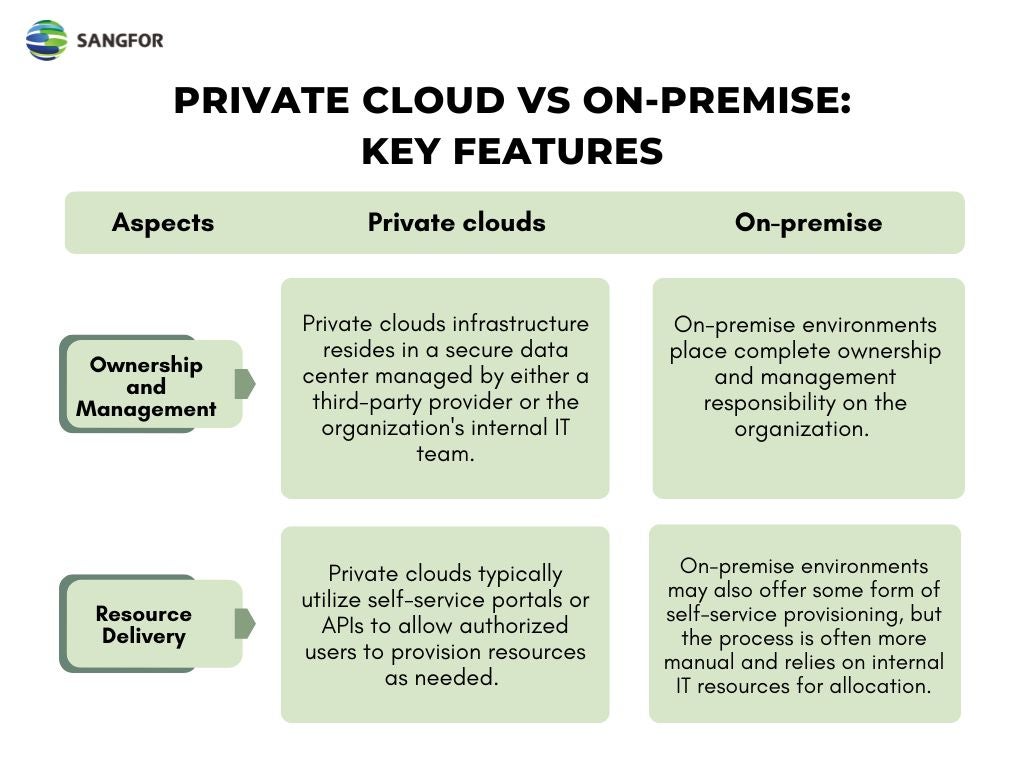As businesses have evolved and IT demands have grown, the way we store and manage data has undergone a significant shift. Traditionally, organizations relied on on-premise infrastructure, housing all their IT resources within their physical facilities. However, the emergence of cloud computing introduced a new paradigm. Today, the debate of private cloud vs on-premise infrastructure arises as businesses seek the optimal balance between control, security, and flexibility for their IT infrastructure needs. This comprehensive guide explores the key differences between these two models, helping you determine the most suitable solution for your organization.
The Definition of Private Cloud
A private cloud is a cloud computing environment built exclusively for a single organization. It mirrors the service model of the public cloud, offering on-demand resources such as storage, computing, and network delivered over the Internet or a private network connection.
However, unlike the public cloud where resources are shared among multiple tenants, a private cloud dedicates these resources solely to a single organization. This dedicated infrastructure resides within a secure data center, often physically separate from the public internet, for enhanced control and security.
The Definition of On-Premise Cloud
On-premises cloud, also known as on-premise infrastructure, represents a traditional data center model where an organization or company owns and manages all the hardware and software within its IT infrastructure. This infrastructure is physically located on-site, within the company's own facilities.

Private Cloud vs On-Premise: Key Features
When it comes to the concept of private clouds vs on-premise environments, it’s important first to identify their distinctions in several aspects, which include ownership, management, and resource delivery models.
- Ownership and Management: Private clouds offer a hybrid approach. The underlying infrastructure resides in a secure data center managed by either a third-party provider or the organization's internal IT team. This dedicated infrastructure provides a level of control similar to on-premise solutions but with the expertise and management capabilities of a cloud provider. On-premise environments, on the other hand, place complete ownership and management responsibility on the organization. This includes managing all hardware, software, and security configurations within the IT infrastructure.
- Resource Delivery: Both private clouds and on-premise environments can offer on-demand resource provisioning and elasticity. However, the delivery model differs. Private clouds typically utilize self-service portals or APIs to allow authorized users to provision resources as needed. This delivers a cloud-like experience with increased agility for development and deployment tasks. On-premise environments may also offer some form of self-service provisioning, but the process is often more manual and relies on internal IT resources for allocation.

Private Cloud vs On-Premise: Advantages
Depending on the specific organizational needs of your company, a private cloud and an on-premise environment each present different advantages in several major aspects for your consideration.
Security and Control
Private clouds provide a balance between security and control. While organizations relinquish some physical control over the infrastructure compared to on-premise environments, they gain a dedicated environment with enhanced security features and compliance certifications. This can be advantageous for businesses in regulated industries or those handling sensitive data.
On the other hand, on-premise solutions can maximize your level of control over hardware, software, and security configurations. This granular control allows organizations to tailor their infrastructure to meet their specific needs and preferences. Still, this structure and solution also come with the responsibility of implementing and maintaining robust security measures.
Scalability
Both private clouds and on-premise environments offer scalability and agility to varying degrees for you.
With careful strategic planning, on-premise solutions can adapt to changing resource requirements through investment in hardware and software. Their expenses are typically predictable without variable costs associated with cloud services. This can be an advantage for businesses with stable and well-defined resource needs.
On the other hand, private clouds provide on-demand resource provisioning and elasticity, similar to the public cloud. This allows organizations to quickly scale resources up or down to meet fluctuating workloads, which is crucial for businesses with unpredictable demands. However, it’s important to note that private clouds are likely to require ongoing subscription fees for the infrastructure and potentially some management services.
Reduced IT Burden and Data Protection
Private clouds can help reduce the IT burden on organizations by leveraging the expertise of a cloud provider to handle certain infrastructure management tasks. This frees up internal IT resources to focus on core business initiatives. Additionally, some private cloud providers offer managed service options that further reduce the IT burden.
On-premise environments, while requiring a more robust internal IT team for management and maintenance, allow businesses to better protect their data with a centralized physical data location infrastructure. This can be critical for organizations in heavily regulated industries or those handling sensitive data, where strict data privacy regulations must be met.
Private Cloud vs On-Premise: Disadvantages
Although private cloud and on-premise infrastructure organizations offer numerous advantages, some drawbacks should be taken into consideration before choosing between the two models.
Limited Scalability and Agility
While private clouds offer some degree of scalability, they may not be as unrestricted as the public cloud. Scaling limitations can arise due to the finite capacity of the dedicated infrastructure, and scaling operations may require coordination with the cloud provider.
On-premise environments can face even greater scalability constraints, as adding new resources often requires physical hardware upgrades, which can be a time-consuming and expensive process. This lack of scalability can hinder the ability to adapt to rapidly changing business needs and lead to vendor dependence if the organization lacks the expertise to manage unforeseen scaling requirements.
Cost Concerns
It’s very common for private clouds to have vendor lock-in, especially if you become heavily reliant on a specific provider's proprietary software or management tools. As a result, switching providers in the future can be complex and costly for your organization.
The same goes for on-premise infrastructure. While it does not tie you to a specific vendor, this flexibility comes with a significant upfront cost burden for hardware, software licenses, and data center space. Additionally, managing an on-premise infrastructure may require you to hire a skilled IT team to handle ongoing maintenance, upgrades, and security patching, which can increase organizational expenses for smaller organizations.
Private Cloud vs On-Premise: Use Cases
Learning the different use cases across industries and in various areas is crucial in the debate of private clouds vs on-premise infrastructure, as it helps you determine which model is most effective for your business.
Data Privacy and Regulatory Compliance
Private clouds are a compelling choice for organizations prioritizing security and compliance. They offer enhanced security features and control over data, making them ideal for meeting regulatory compliance requirements for industries like finance, healthcare, and government. These industries are often subject to strict regulations like HIPAA and PCI-DSS, and private clouds allow organizations to maintain full control over their data and infrastructure, ensuring adherence to these regulations.
On the other hand, on-premise environments allow organizations to have complete control over physical access to hardware, network security configurations, and data residency. This can be crucial for businesses in industries adhering to strict data sovereignty regulations, where data must remain within specific geographic boundaries.
Workload Management
Private clouds excel at supporting high-performance computing (HPC) workloads. Their scalable infrastructure and ability to provision resources on-demand make them ideal for tasks like scientific simulations, engineering applications, and big data analytics, as these workloads often require significant processing power, memory, and storage, which private clouds can deliver efficiently.
On-premise infrastructure is also well-suited for running customized or legacy applications that have specific dependencies or configurations, as these applications may not function optimally in a cloud environment due to compatibility issues or reliance on specific hardware or software resources.
Hybrid or Multi-Cloud Scenarios
A hybrid approach that combines private cloud and on-premise infrastructure offers the flexibility to manage a mix of workload requirements. Sensitive data and mission-critical applications can reside in the secure and controlled environment of a private cloud. Less critical workloads that are more cost-sensitive or have specific hardware requirements can be housed on-premise. Additionally, private clouds can be leveraged for multi-cloud deployments, enabling organizations to seamlessly integrate with public cloud environments to particular workloads that require additional scalability or specialized services.
Private Cloud vs On-Premise: Setup and Configuration
The setup and configuration processes for private clouds and on-premise environments differ significantly in terms of complexity, involvement, and ongoing management requirements.
Setting up a Private Cloud
Setting up a private cloud generally requires you to seek collaboration with a cloud service provider (CSP). The CSP will guide you through the process:
- Planning and Design: The CSP will assess your needs and design a customized private cloud infrastructure.
- Hardware Selection and Procurement: The CSP will assist in selecting appropriate hardware components to build the private cloud infrastructure, including servers and storage devices.
- Software Installation and Configuration: The CSP will install the necessary software components, such as a hypervisor and a cloud management platform, to create the private cloud environment.
- Network and Security Configuration: The CSP will configure the private cloud network to ensure secure communication and data isolation. They may help set up VLANs, firewalls, and access control lists (ACLs).
- Deployment: Once the infrastructure is configured, the CSP will deploy your workloads onto the private cloud, migrating existing applications or deploying new ones.
Setting up On-Premise Infrastructure
Your organization's IT team typically shoulders the entire responsibility for deployment, configuration, and ongoing maintenance:
- Hardware installation: The IT team will physically install and configure the servers, storage devices, networking equipment, and security appliances.
- Software configuration: They will install and configure your operating systems and applications required for your workloads.
- Network security setup: They will set up firewalls, VLANs, and access control lists (ACLs) to secure your network and data.
- Ongoing patching: They will regularly apply security patches and updates to operating systems and applications.
- Monitoring: They will proactively monitor system performance and resource utilization and identify any security threats or technical issues that may arise within the infrastructure.
How Can Sangfor Help You with Our Cloud Solution?
Sangfor Enterprise Cloud Platform (Sangfor SCP) empowers businesses to navigate the cloud landscape with a comprehensive suite of solutions. Built on a business-centric HCI (Hyperconverged Infrastructure) framework, Sangfor SCP offers a secure and scalable private cloud foundation. It caters to diverse needs, providing options for managed cloud, data backup and recovery, and hybrid cloud as a Service (PaaS) platform.
Sangfor SCP simplifies private cloud management with a user-friendly interface and automates various tasks, freeing up IT resources. Furthermore, Sangfor SCP prioritizes security and reliability with built-in security features and fault tolerance mechanisms. Its hardware compatibility ensures smooth integration and scalability for future growth.
Whether your organization seeks a complete private cloud solution or a hybrid approach, Sangfor SCP offers the flexibility and features to meet your unique cloud computing requirements. Contact us to learn more about how we can empower your businesses today.
People Also Ask
It’s important to understand that IT expertise is required to manage and maintain each option. Private clouds often require less internal IT knowledge for day-to-day operations, as the cloud provider handles some infrastructure management tasks. This can free up your IT team to focus on core business initiatives. However, as mentioned, a reliance on the cloud provider may make the process of switching providers complex and expensive in the future. On-premise infrastructure, on the other hand, necessitates a robust IT team with the skills to manage and maintain network security, hardware, and various updates. While this approach offers greater control and customization, a significant investment in IT resources is needed.





